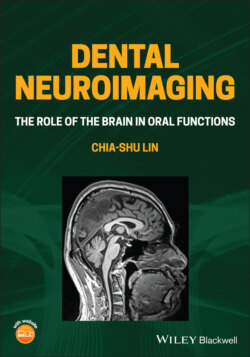Читать книгу Dental Neuroimaging - Chia-shu Lin - Страница 39
1.2.5.1 Blood‐Oxygen‐Level‐Dependent fMRI
ОглавлениеThe blood‐oxygen‐level‐dependent (BOLD) fMRI detects the changes in the proportion of deoxygenated and oxygenated haemoglobin in the brain. This metabolic event (i.e. oxygenation of haemoglobin) is further associated with neural activity. Firstly, the brain region with increased neural activity is associated with more energy consumption, i.e. for synaptic activity. Secondly, oxygen consumption is associated with increased CBF and changes in cerebral vessel volume, leading to an over‐supply of the oxygenated vs. deoxygenated haemoglobin (see Section 2.2). Finally, deoxygenated haemoglobin shows a paramagnetic property that disturbs the local magnetic field and decreases the MR signal (Thulborn et al. 1982). A higher MR signal reflects the effect of an increased proportion of oxygenated vs. deoxygenated haemoglobin, i.e. the BOLD effect, coupled with increased neural activity. In a task‐based fMRI study, researchers can infer that a mental function is associated with a specific brain region by identifying changes in the BOLD signal in the brain region. Therefore, the discovery of the BOLD effect is essential for brain mapping, i.e. to map the location of brain activation associated with functions (Jenkinson and Chappell 2018).
